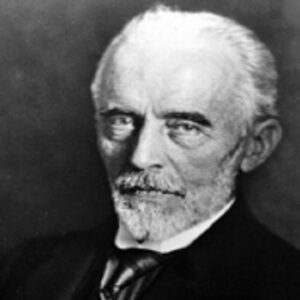Emil Theodor Kocher was the first surgeon to perform thyroid gland, hernia, and abdominal surgery. He became an expert in the treatment of dislocated shoulders and gunshot wounds as well. Kocher was a strong supporter of Joseph Lister, the pioneer of antiseptic surgery, and began performing antiseptic treatments himself with great success. Kocher’s surgeries were successful in the majority of the patients. In 1909, he was awarded the Nobel Prize in Medicine for his work on goiter and other thyroid disorders. Kocher was the first surgeon to perform a thyroidectomy to treat goiter. He also published a paper on cretinism (a condition caused by a thyroid hormone deficiency that begins at birth and is characterized by dwarfism and mental disorders), explaining that cretinism is caused by a lack of thyroid function and that it can be prevented. Kocher’s research and findings aided and inspired a generation of physicians, surgeons, and medical students.
Education And Childhood
Emil Theodor Kocher was born in Berne, Switzerland, on August 25, 1841. Kocher was quiet, modest, and studious as a child. He went on to study at the University of Berne, where he graduated in 1865, after completing his early education.
He went on to study with Langenbeck, Billroth, and Lücke in Berlin, London, Paris, and Vienna. Kocher was the most influenced by Billroth of all his teachers.
Career of Theodor
Kocher visited various clinics in Europe, including Vienna, while studying under Billroth. While working as an assistant to Professor Lucke, he began publishing experimental works on hemostasis from 1866 onwards.
His work on a new method for treating dislocated shoulders catapulted him into the spotlight. His dislocation treatment methods were widely praised for their simplicity and effectiveness. After George Albert Lucke’s death in 1872, Kocher was appointed as a professor at Berne’s surgical clinic.
Kocher published reports on his goiter operations in 1872 and 1874. Only two deaths were reported out of a total of thirteen, after which he continued to conduct goiter-related experiments.
He published his articles on the 101 goiter surgeries he performed in 1883. Kocher described the procedures for operating on a goiter patient in detail in his articles. He described a procedure known as total thyroidectomy, which entails the removal of the thyroid gland entirely.
He discovered, however, that even after total thyroidectomy, patients develop a distinct streak of cretinism. He treated goiter in the skin, muscle, peritoneum, arteries, intestine, and other body parts and organs. He discovered that total thyroidectomy had a transient effect on the patients after further investigation.
Either the patients died within seven years of surgery or developed goiter later in life in those who lived longer. Kocher called the symptoms after a thyroidectomy “operative myxedema.”
Weight gain, hair loss, tongue thickening, and abnormal heart rates were among the symptoms of myxedema patients. Kocher performed 100 surgeries, and at least 30 of them resulted in serious complications.
These diseases were discovered to be caused by a lack of thyroid secretions, which are required by the human body. Kocher explained hypothyroidism, a condition in which the thyroid gland stops producing thyroid hormone, as a case that, in addition to being surgical or congenial, could also be due to goiter.
Kocher published the results of his next 250 goiter surgeries in 1889. He pioneered a procedure known as “inucloatin resection.”
This is still the standard procedure for treating nodular goiters all over the world. Kocher described the collar incision method as well as the process of leaving the healthy thyroid tissues intact, ensuring the recurrent laryngeal nerve and parathyroid glands’ proper and adequate functioning. Kocher’s never-ending research on thyroid functions continued, and he also demonstrated the importance of iodine in the prevention of goiter.
In Medicine, the Nobel Prize
Kocher was awarded the Nobel Prize in Medicine in 1909 for his groundbreaking research on the thyroid gland’s function. He had already performed 2000 thyroid surgeries by 1912.
Other Significant Developments
One of Kocher’s most important contributions is his work on hernia surgery. He devised the new pylorectomy procedure (the surgical removal of pylorus part of the stomach).
Kocher’s other notable accomplishments include the surgical removal of gall stones from the bile duct and improvements in duodenum operations.
Personal Death and Life
Kocher had three sons with Marie Witchi, with whom he was married. Albert, his eldest son, became an Assistant Professor of Surgery and worked alongside his father.
Death and the Afterlife
Kocher died in Berne on July 27, 1917. Kocher’s theories on thyroid disorders aided in the discovery of cures for related diseases. In addition, he was the first surgeon to perform more than 5000 operations.
He was also one of the first to take asepsis seriously and work on developing infection-free surgical methods. Kocher made significant contributions to the treatment of diseases of the stomach, lungs, intestine, and gall bladder, including findings on the function of the thyroid gland and the treatment of goiter.
He had an indelible impact on almost every branch of modern surgery.
Major Projects Theodor
Kocher’s work includes research and detailed writings on a variety of surgeries for various diseases. One of his early works was “Über Schusswunden” (on gunshot wounds).
The majority of his works are devoted to the treatment of goiter and other thyroid disorders. “Magenresektion” (stomach resection), “Excisio recti” (rectum excision), “Mobilisierung des Duodenum” (duodenum mobilization), and “Chirurgische Operationslehre” are some of his other works (Theory on surgical operations).
Estimated Net Worth
Theodor is one of the wealthiest doctors in the world, as well as one of the most popular. Theodor Kocher’s net worth is estimated to be $1.5 million, according to Wikipedia, Forbes, and Business Insider.


